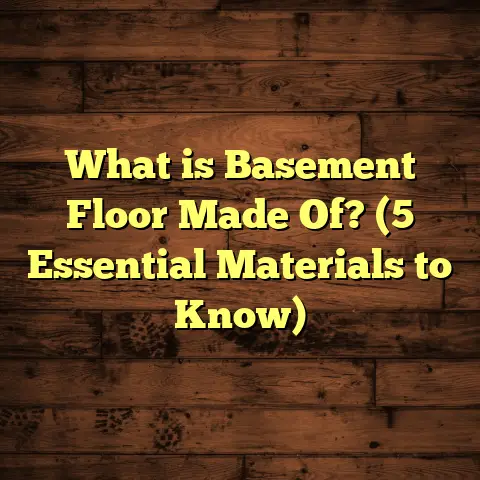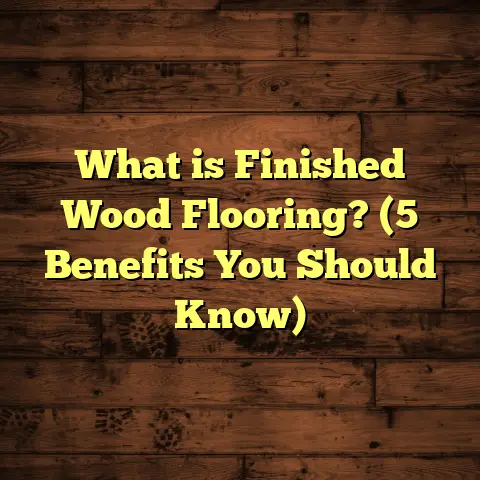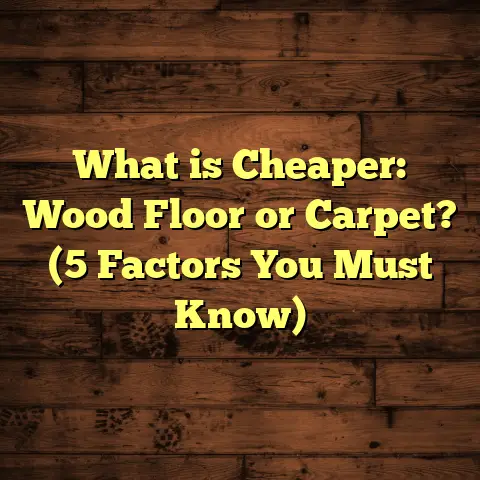What is Wooden Flooring Called? (5 Types You Need to Know!)
What is Wooden Flooring Called?
When people talk about wooden flooring, I often get asked: “What exactly is wooden flooring called?” It’s a simple question but the answer opens up a surprisingly wide world of options. Wooden flooring doesn’t just mean one thing. It can refer to several types of floors made from wood or wood-based products, each with its own characteristics, installation techniques, costs, and maintenance requirements.
I want to share what I’ve learned after years of working hands-on with different kinds of wood floors—installing them in homes, offices, rental properties, and even commercial spaces. More than that, I want to give you a clear picture of what each type is, how it performs, and why you might choose one over another.
Wooden flooring is functional—it can withstand foot traffic, provide insulation, and resist wear if you choose wisely. But it also adds character and warmth to your space. So, let’s start by defining exactly what wooden flooring means, then I’ll share the five types I believe everyone should know about.
What is Wooden Flooring?
At its simplest, wooden flooring refers to any floor covering made primarily from wood or wood-derived materials. This includes floors made of solid wood planks, engineered wood products, and sometimes even materials that mimic wood’s look and texture.
The primary defining feature is that the surface you walk on has some form of wood visible—a natural grain or texture that brings warmth and natural beauty indoors.
But when you drill down into the details, wooden flooring spans a diverse range of materials and construction methods:
- Solid hardwood is sliced directly from a log and milled into thick planks.
- Engineered wood layers real wood veneers over plywood or fiberboard.
- Laminate flooring uses a photographic image of wood grain pressed onto composite boards.
- Bamboo, while technically a grass, is processed into planks that behave like hardwood.
- Reclaimed wood repurposes old wood from barns or factories into new flooring.
So when someone asks me “what is wooden flooring called,” I usually follow up with: “Which kind are you interested in?” Because knowing the type helps you understand everything from durability to cost.
Why Does Knowing the Different Types Matter?
I’ve seen too many clients pick a wooden floor based on looks alone. Months later, they call me frustrated because the floor scratched easily or warped in the humidity. Knowing what type of wooden flooring you’re dealing with upfront can prevent these issues.
For example, solid hardwood floors have a timeless appeal and can be refinished multiple times. But they’re not great in damp environments. Engineered wood offers a balance—it looks like hardwood but stands up better to moisture. Laminate floors are affordable and easy to install but can’t be refinished once damaged.
Understanding these differences will save you money and stress in the long run.
1. Solid Hardwood Flooring: The Classic Choice
Solid hardwood flooring is what most people think of when they hear “wooden floor.” It’s made from a single piece of solid wood, typically cut into planks about ¾ inch thick. Species like oak, maple, cherry, and walnut are popular choices.
Why I Like Solid Hardwood
When I installed solid hardwood in an old farmhouse renovation, I was struck by how much personality each plank had. The natural grain patterns told a story. Walking on those floors felt warm underfoot and gave the home an authentic charm.
One thing I love about solid hardwood is its longevity. If it gets scratched or worn down over time—which it will in busy homes—you can sand it down and refinish it multiple times. This can extend the life of your floor by decades.
Installation & Maintenance
Installing solid hardwood requires a stable subfloor and usually involves nailing or stapling the planks down. The process takes time but results in a durable surface.
Maintenance involves regular sweeping or vacuuming, occasional polishing, and refinishing every 7-10 years depending on wear.
Data & Durability
According to the National Wood Flooring Association (NWFA), solid hardwood floors can last anywhere from 25 to 100 years with proper care. They can be sanded and refinished up to 7 times before the wood becomes too thin.
The Janka hardness scale measures wood’s resistance to denting and wear. For example:
- Red oak (a common choice) scores about 1290.
- Hard maple scores about 1450.
- Hickory scores around 1820.
Higher numbers mean harder wood that resists dents better.
Cost Considerations
Solid hardwood flooring typically costs between $8 and $14 per square foot installed. The material cost alone ranges from $3 to $10 depending on species and grade.
Though pricey upfront, the investment pays off for many homeowners due to durability and timeless appeal.
2. Engineered Wood Flooring: Hardwood’s Practical Cousin
Engineered wood has become increasingly popular over the past decade. It consists of a thin layer of real hardwood (veneer) bonded on top of several layers of plywood or high-density fiberboard (HDF). This layered construction adds stability.
My Experience with Engineered Floors
I installed engineered wood in a client’s basement where moisture was a concern. Solid hardwood wasn’t suitable because it would have warped or cupped over time. Engineered wood handled the humidity better—it stayed flat and looked just like real hardwood.
The versatility of engineered wood is impressive. You can install it over concrete slabs or radiant heating systems where solid wood would struggle.
Pros and Cons
Pros:
- More resistant to moisture and temperature changes.
- Can be installed in areas where solid hardwood isn’t recommended.
- Often available in wider plank sizes.
- Usually easier to install with click-lock systems.
Cons:
- The veneer layer is thin; limited refinishing options (usually only once or twice).
- Typically less expensive than solid hardwood but not cheap.
Data Insights
Recent market data shows engineered wood now accounts for roughly 40% of all wood flooring sales in North America. Its practical benefits appeal to homeowners wanting hardwood looks without some risks.
Thickness of the veneer layer varies from 1mm to 4mm. The thicker the veneer, the more times it can be sanded and refinished.
Pricing
Engineered wood costs about $6-$12 per square foot installed. The price depends on species, veneer thickness, core material quality, and finish type.
3. Laminate Flooring: Wood Lookalike on a Budget
Laminate flooring often gets lumped with wooden floors but technically it’s different. It’s made of several layers of composite materials topped with a photographic image layer that mimics wood grain, sealed by a clear protective coating.
Why I Recommend Laminate for Certain Jobs
I’ve installed laminate flooring many times in rental properties or places where budgets were tight. It looks surprisingly good from a distance and holds up well under normal wear if installed correctly.
For families with kids or pets who want an affordable option that’s easy to replace when damaged, laminate makes sense.
What You Get—and What You Don’t
Laminate can’t be sanded or refinished if scratched or dented. Also, it doesn’t feel as warm or authentic underfoot compared to real wood.
Installation is usually DIY-friendly with click-lock planks laid over a foam underlayment.
Market Stats
Laminate flooring sales in the US topped $2 billion recently as many homeowners turn to DIY projects during home renovations.
Durability varies widely by quality:
- Entry-level laminates may scratch easily.
- Premium laminates offer higher abrasion resistance (AC3 – AC5 ratings).
Price Range
Laminate flooring is the most affordable option here at $1.50-$5 per square foot installed. This makes it attractive for large areas with tight budgets.
4. Bamboo Flooring: A Grass That Acts Like Wood
Bamboo flooring surprises lots of people because bamboo isn’t technically wood—it’s a fast-growing grass. But processed bamboo planks behave very similarly to hardwood floors in terms of durability and appearance.
My Personal Take on Bamboo
I chose strand-woven bamboo for my home office because I wanted something eco-friendly and stylish. It looks clean and modern but feels tough underfoot—much harder than many hardwoods I’ve worked with.
Bamboo grows quickly—just 3-5 years compared to decades for most hardwood trees—making it one of the most sustainable flooring options available today.
Types of Bamboo Flooring
- Horizontal: Shows bamboo stalks’ natural nodes.
- Vertical: Thin layers glued together vertically.
- Strand-woven: Bamboo fibers shredded and compressed under heat/pressure for extreme hardness.
Strand-woven bamboo scores around 3000-4000 on the Janka hardness scale—making it harder than oak or maple.
Environmental Impact
Because bamboo regenerates rapidly without replanting required (it grows back from root systems), it’s gaining favor among environmentally conscious consumers.
Cost & Installation
Bamboo flooring costs about $5-$8 per square foot installed. Installation methods are similar to other engineered woods—nail down or click-lock systems depending on product type.
5. Reclaimed Wood Flooring: History Beneath Your Feet
Reclaimed wood flooring takes old wood salvaged from barns, factories, warehouses, or even wine barrels and repurposes it as new flooring planks.
Why I’m Drawn to Reclaimed Wood
I love telling clients that their floor has a story—sometimes hundreds of years old! One project involved using pine reclaimed from a 19th-century barn for a rustic cabin vibe. Every knot, nail hole, and weathered crack added character no new floor could match.
Reclaimed wood appeals not just for its aesthetic but for its environmental benefits—recycling old materials rather than cutting down fresh trees.
Challenges
Reclaimed wood requires more prep work:
- Removing old nails carefully
- Sanding uneven surfaces
- Sometimes treating for pests or mold
But the end result is worth it for many homeowners wanting unique charm.
Costs
Reclaimed wood tends to be more expensive due to labor-intensive processing—expect $8-$15 per square foot installed depending on source quality and condition.
How These Types Stack Up Against Each Other
So you’ve got five different wooden floor options on your radar now. How do you decide which one works best? Here’s a quick comparison table based on my experience:
| Type | Durability | Moisture Resistance | Cost (per sq.ft) | Installation Difficulty | Maintenance | Refinishing Potential |
|---|---|---|---|---|---|---|
| Solid Hardwood | Very High | Low | $8 – $14 | Moderate | Regular sweeping & refinishing | Up to 7 times |
| Engineered Wood | Medium-High | Medium | $6 – $12 | Easier | Sweeping & gentle cleaning | Limited (1-2 times) |
| Laminate | Medium | Medium-Low | $1.50 – $5 | Easy | Replace damaged planks | None |
| Bamboo | High (strand-woven) | Medium | $5 – $8 | Moderate | Similar to hardwood | Limited |
| Reclaimed Wood | Varies | Low | $8 – $15 | Difficult | Depends on condition | Up to 3 times |
My Tips for Choosing Wooden Flooring
Choosing wooden flooring isn’t just about picking what looks good. Ask yourself:
- How much foot traffic does this area get?
- What’s my budget for materials and installation?
- Are there moisture concerns (basements, bathrooms)?
- How much maintenance am I willing to do?
- Do I want something eco-friendly?
These questions helped me guide clients toward floors that fit their lifestyle rather than just aesthetics alone.
Personal Story: How FloorTally Changed My Workflow
Cost estimation used to be one of my least favorite parts of flooring projects—juggling numbers from suppliers, labor quotes, waste percentages… it was tedious. Then I found FloorTally.
FloorTally lets me plug in room measurements, pick materials from an extensive list (including all these wooden options), add labor rates specific to my area, and automatically calculate total costs including waste factors.
It saves me hours per project and helps me present clients with realistic budgets upfront so there are no surprises later.
For example, I recently planned a mid-sized living room project comparing solid oak vs engineered maple using FloorTally side-by-side. The tool showed labor cost differences clearly since engineered installs faster but has higher material cost per square foot. That insight helped my client make an informed choice quickly without guesswork.
Maintenance Secrets That Keep Wooden Floors Looking Great
Wooden floors need care but nothing crazy:
- Always sweep/vacuum dirt regularly—grit scratches finishes quickly.
- Use mats at entryways.
- Avoid wet mopping; use damp cloths instead.
- For solid hardwoods: schedule refinishing every decade or so.
- Engineered woods: stick with non-abrasive cleaners designed for wood.
- Replace damaged laminate planks immediately.
I once ignored these tips while renovating an Airbnb unit; pet claws quickly ruined laminate floors leading to costly replacements two years later! Now I preach prevention loudly.
Final Thoughts on Wooden Flooring Choices
Wood floors are beautiful investments that add value and comfort to your home or business. Understanding what “wooden flooring” means gives you control over your project outcome—from choosing the right product for your environment to budgeting wisely for installation and upkeep.
Whether you want classic solid hardwoods that last generations or budget-friendly laminates for practicality—or even sustainable bamboo or unique reclaimed woods—I hope this guide helps you feel confident in making your selection.
If you want help narrowing down choices based on your specific needs or just want some honest advice about installation challenges, feel free to reach out anytime!
Frequently Asked Questions About Wooden Flooring Types
Q: Can engineered wood be installed in bathrooms?
A: Generally no; bathrooms have high moisture levels that can damage most wooden floors including engineered wood unless specifically rated for wet areas.
Q: How long does laminate flooring last?
A: Typically 10-20 years depending on quality and traffic but cannot be refinished once damaged.
Q: Is bamboo harder than oak?
A: Strand-woven bamboo is harder than many oak species based on Janka hardness tests.
Q: What’s the benefit of reclaimed wood besides aesthetics?
A: Reduced environmental impact by recycling existing materials plus unique character not found in new lumber.
Q: How often does solid hardwood need refinishing?
A: Usually every 7-10 years depending on wear; sanding removes surface scratches restoring original look.
If you want me to help customize this advice further for your project specifics or budget constraints, just ask!





